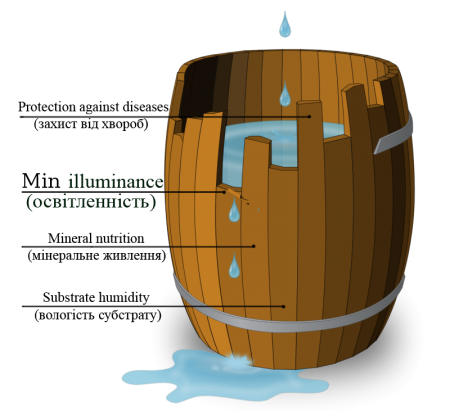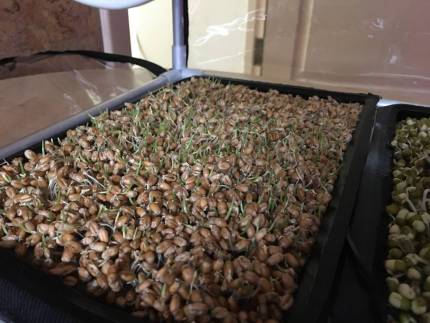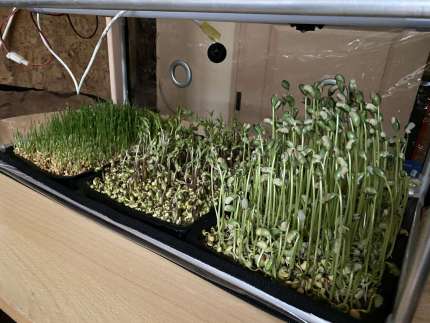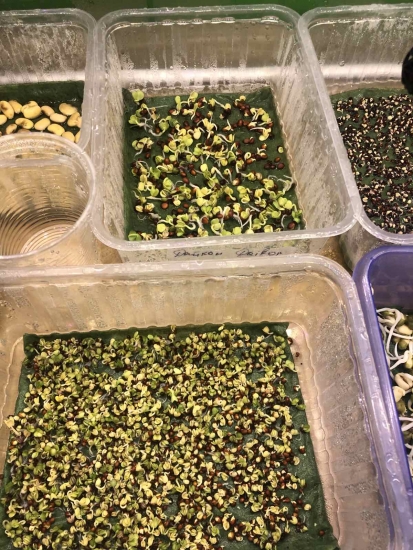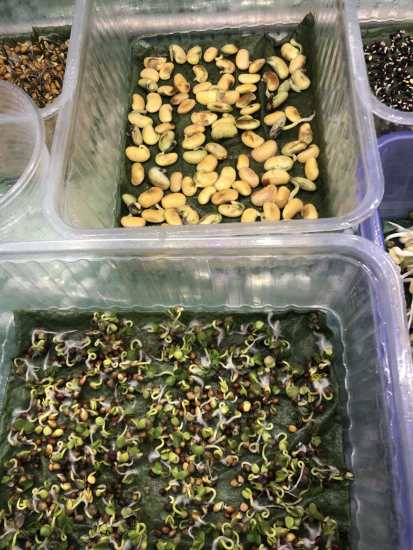(* from Latin substratum “lining, litter”, from the point of view of nature – the surface on which the object is placed; From the point of view of biology – a breeding ground for plants and bacteria.)
Growing microgreen both a simple and complex process. It is simple in that it does not require large investments of finance and time. The difficulty lies in choosing the right substrate for growing microgreens. The most popular types of substrates are paper, fabric, linen / rope mats, mineral wool, coconut, peat, soil. Some grow microgreens with no lining at all, but this is not the way for the lazy.
Now we will deal with each method separately, determine the pros and cons. But first you need to understand what plants need to germinate, grow healthy and bring benefits to human health. There are “four pillars” on which to grow success:
- Disease resistance. It can be natural immunity, or artificial defense. Artificial protection means the treatment of seeds against mold, fungi, viruses, etc. In the case of micro greening, this can be treatment with hydrogen peroxide, 30 ml of a 3% solution per 1 liter of water, ozonation, etc.
- Food (mineral / organic). This “pillar” is of particular importance when grown without bedding, on rock wool. Since in these methods, the food must be added separately. It should be remembered about the pH level (for microgreens it should be at 5.5 – 6.0) and the salt content (500-600 PPM).
- Moisturizing. Comments are superfluous here, because no living organism on the planet can survive without water.
- Shine. Photosynthesis will not take place in plant cells without light. When growing microgreens, not all crops need light. Such are soybeans and corn – when grown in the world, seedlings accumulate bitterness. All other crops require 14-16 hours of daylight.
Let’s take a simpler example. Imagine that we sowed seeds, provided them with organic nutrition, sufficient watering, treated them for diseases before sowing, but the seeds would be limited by lighting. This can be seen in the figure. The short board is designated as light. The essence of the model is that if the liquid begins to overflow over the shortest board when filling the barrel, then the length of the others no longer plays any role.
Let’s go back to the methods of growing microgreens.
Growing unlined. The process involves flushing the seed and placing it in a growing container, followed by spraying or watering the seed. Watering is needed in moderation, since the roots of plants also need air. This is necessary in order to avoid rotting seeds and the appearance of fungi.
This method does not require any investment – you need seeds, a container for growing and water. This is an undeniable plus. But at the same time, this method has a minus – the seeds need to be watered, or sprayed at intervals of 2-6 hours. This method is suitable for homeowners or those who work from home. Another disadvantage is that not all crops are suitable for this method. For example, radish, kohlrabi, broccoli, Daikon are very fond of water, especially in the seedling stage. Cereals (oats, rye, wheat, corn) are well suited for this method; from legumes, Mash beans feel good.
Growing on paper. This method usually uses soft tissue paper or towels. The method is also not expensive, this is a plus. It is the paper backing that contains an additional supply of moisture, which allows you to increase the interval between watering or spraying. The downside is when the sprouts begin to grow more actively, this supply of water will not be enough for a long time. Therefore, this method is also not quite suitable for full-time people. For the same radish, kohlrabi and broccoli, this option is not the best for the cereal has a chance to exist.
Growing on fabric. Usually they use gauze folded in several layers, or other synthetic or natural fabric. This method is much more expensive compared to the two previous ones. Fabrics, especially natural ones, contain a much higher moisture reserve than paper. This way of growing is suitable for busy people, but requires a regimen. Watering, especially when the sprouts begin to grow actively, should also not be forgotten.
Growing on rugs. Rugs are ideal in terms of price-quality ratio. The bedding is quite cheap – 1 rug measuring 10 * 15 cm costs ≈ 3 UAH (0.10 $). At the same time, it perfectly retains water. Due to its structure, it allows air to get to the roots (provided that the mat is not flooded).
Growing in this way allows you to reduce the frequency of watering or spraying – therefore, it is optimal for busy people. Suitable for all crops, without exception. It is also worth choosing the right mat material. Better moisture retention 100% linen mat. Rugs made of 100% harness absorb moisture less well. Linen rugs with the addition of a rope are also not the best choice.
Growing on mineral wool. This material holds moisture well enough, allows you to increase the interval between watering even more – this is a significant advantage over other methods. Also in this substrate, the root system develops well. At the same time, this material has a big drawback – it is not very convenient to use, when cutting the material, its microscopic particles get stuck in the skin and cause unpleasant sensations. Since the material does not contain any nutrients in its composition, it must be “charged” with fertilizers and the correct pH. Also, this material is not cheap. Optimal for those who plan to equip farms for growing microgreens. This will reduce the workforce by reducing the frequency of watering. Suitable for small crops (cilantro, beetroot, basil) – they are easy to cut,
Growing on coconut. Simple and cheap material ($ 0.32 per kg, not buffered coconut) in which everything grows well. Of the advantages – stable in all respects, holds a lot of air, greens do not need to be watered. Of the minuses – you need to properly buffer (1kg of coconut / 3l of water) and fill with fertilizers (calcium and magnesium sulfate).
Growing on peat. Growing this way has more disadvantages than advantages. Firstly, peat has an unstable pH, nitrogen content and phytopathology, so they need to be controlled with special means. Secondly, with this method it is difficult to keep the greenery clean. Thirdly, this is not a cheap option. Among the advantages, one can only highlight the fact that this method is suitable for all crops, and the fact that peat retains water quite well.
Growing on the ground. Growing plants on soil is a classic agricultural technique in crop production. The method also has its negative and positive aspects. The positive include the uselessness of fertilization. To negative – dirt on greenery, frequency of watering, price.
Growing on argopelter and vermiculite. They are often added to soil, peat or coconut in order to better retain moisture in them. The advantages of this substrate is that when grown on it, the manifestation of fungal diseases, mold is less often observed, it protects the root system from temperature extremes. Plants remain clean when grown. However, it contains no nutrients at all, so you need to use fertilizers and bacteria to create the right microflora. Another disadvantage is that only complex fertilizers should be used as fertilizers. Since calcium fertilizers shift the neutral pH of argopelter to the alkaline side. For this substrate 9 UAH / l (about $ 0.30).
Each of the substrates has its own advantages and disadvantages. Which one has more advantages, which one has more disadvantages. The choice of what to use as a substrate is yours. My task is to wish you success in your endeavors.

